Disclaimer: What follows is a work of fiction, inspired by the Magic: The Gathering Universes Beyond Commander deck series. The persons and products mentioned in this article do not exist. All trademarks and copyrighted materials belong to Wizards of the Coast and Larian Studios, respectively.
MTG/DOS2 Commander: Divine Majesty—Reveal and Review
Sept 21, 2024By Joe King
Divine Majesty is one of four new Commander decks released as part of Magic: The Gathering's Larian Studios cross-over Universes Beyond Commander: Divinity Original Sin 2. This precon comes packed with tempting reprints and an interesting strategic mix of aggressive combat-oriented creature strats mixed with a light stax theme which will deprive your opponents of the resources they need to keep up with your aggressive game plan. But how well do these two sides of the deck play together—and is it worth the $40 price tag this deck is commanding at most local gamestores? That's what we're here to find out.
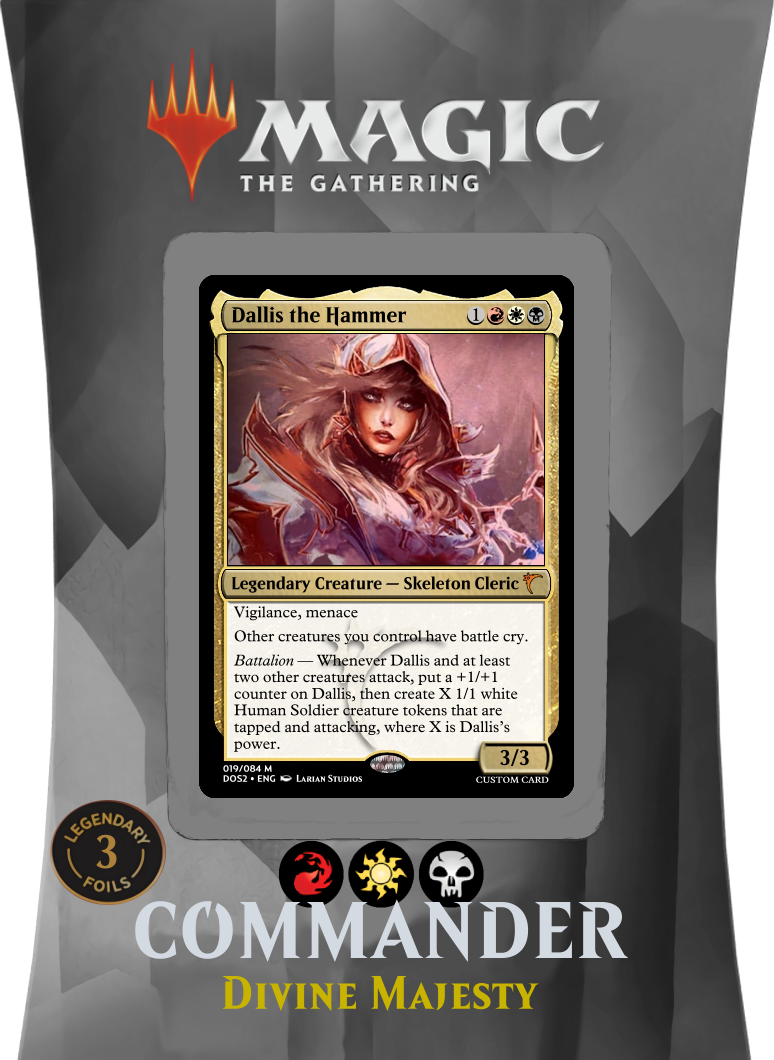
Divine Majesty (Red-White-Black)
RALLY THE TROOPS || TAX THE ENEMY
Similar to the Chaos Reigns deck, Divine Majesty includes a ready-to-play 100-card deck featuring a foil face commander, a foil back-up commander, and a foil Origin character card, along with 16 other new-to-Magic cards (three more than Chaos Reigns). In the case of Divine Majesty, the face commander is Dallis, The Hammer. She is accompanied by a modal double-faced back-up commander with Lucian the Divine on the front face and an enchantment, Lucian's Legacy, on the back. These two are joined by the Red Prince as the Origin character for this deck, appearing here in borderless foil as The Red Prince, Heir to Empire.
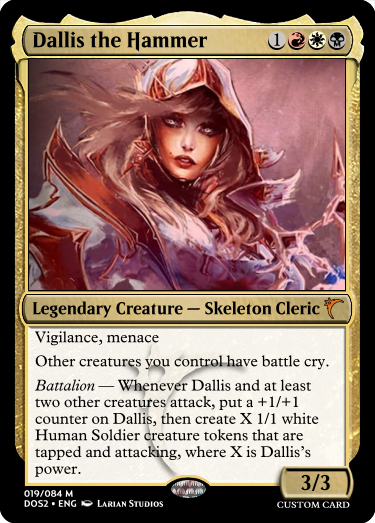
Dallis, The Hammer 1rwb
Legendary Creature—Skeleton Cleric
Vigilance, menace
Other creatures you control have battle cry. (Whenever a creature with battle cry attacks, each other attacking creature gets +1/+0 until end of turn.)
Battalion—Whenever Dallis and at least two other creatures attack, put a +1/+1 counter on Dallis, then create X 1/1 white Human Soldier creature tokens that are tapped and attacking, where X is Dallis's power.
[3/3]
As face commander, Dallis promises an aggressive deck that threatens big damage with relatively little set-up. The keyword combination of vigilance and menace allows Dallis to reliably swing in most every turn, protecting your attacks with built-in evasion while allowing you to keep her as a blocker even as you swing round after round. Her next two abilities give you reason to make sure she isn't attacking alone. By granting battle cry—an old keyword ability from Mirrodin Besieged— to all of your other creatures, Dallis ensures that your whole board will have its power pumped by every other creature you swing with (besides Dallis herself). Add to this her Battalion ability growing her with +1/+1 counters and creating tokens equal to her power, and we have a recipe for a very threatening snowball. Play Dallis turn 3 or 4 with at least two other creatures out (or a hasty creature in hand), then swing all three creatures at the player with the least blockers next turn, and boom! Suddenly Dallis is a 6/4 with Menace who just created six 1/1 tokens tapped and attacking. And, of course, all six of those tokens will have battle cry as well, granting a further +6/+0 to your board when you swing in next turn!
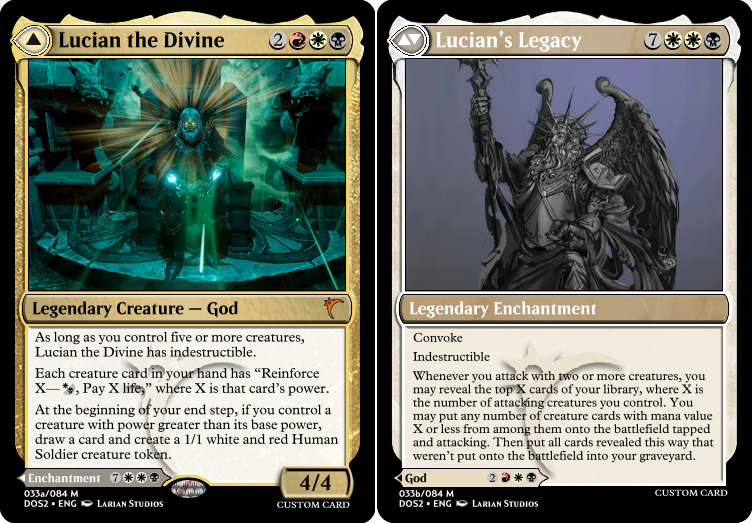
Lucian the Divine 2RWB
Legendary Creature—God
As long as you control five or more creatures, Lucian the Divine has indestructible.
Each creature card in your hand has "Reinforce X—W/B, Pay X life," where X is that card's power. (W/B, Pay X life, Discard this card: Put X +1/+1 counters on target creature, where X is this card's power.)
At the beginning of your end step, if you control a creature with power greater than its base power, draw a card and create a 1/1 white and red Human Soldier creature token.
[4/4]
Lucian's Legacy 7WWB
Legendary Enchantment
Convoke (Your creatures can help cast this spell. Each creature you tap while casting this spell pays for 1 or one mana of that creature's color.)
Indestructible
Whenever you attack with two or more creatures, you may reveal the top X cards of your library, where X is the number of attacking creatures you control. You may put any number of creature cards with mana value X or less from among them onto the battlefield tapped and attacking. Then put all cards revealed this way that weren't put onto the battlefield into your graveyard.
The back-up commander of Lucian the Divine // Lucian's Legacy presents a slightly tougher nut to crack. Where Dallis signals a deck that is exclusively about turning your creatures sideways to hit for big damage and create a shedload of tokens, Lucian seems to promise a more reserved strategy. Granting reinforce to each creature in your hand allows Lucian to turn big creatures you can't play yet into powerful buff spells, while his last ability means that as long as you can keep him alive and even a single +1/+1 counter on him, you are guaranteed a continual baseline of card and board advantage. The enchantment on the back side of the commander offers a pure advantage engine, allowing you to spin creatures off the top of your deck every time you attack. Together, the two halves of Lucian promise an alternative deck geared towards the late game, building up advantage over the course of several turns with a careful management of resources, building a wide board, and then swinging in and using Lucian's Legacy to turn those swings into the overwhelming advantage you need to close out a game of Commander.
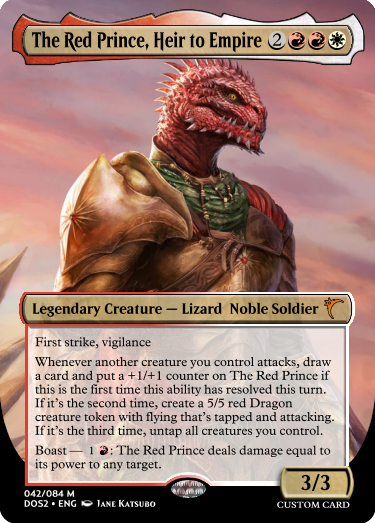
The Red Prince, Heir to Empire 2RRW
Legendary Creature—Lizard Noble Soldier
First strike, vigilance
Whenever another creature you control attacks, draw a card and put a +1/+1 counter on The Red Prince if this is the first time this ability has resolved this turn. If it's the second time, create a 5/5 red Dragon creature token with flying that's tapped and attacking. If it's the third time, untap all creatures you control.
Boast—1R: The Red Prince deals damage equal to its power to any target. (Activate only if this creature attacked this turn and only once each turn.)
[3/3]
The Origin card for this deck is The Red Prince, Heir to Empire, a legendary Boros lizard with two dangerous abilities. The first rewards you for
attacking each turn, granting increasing benefits for each creature you attack with—just one attack will net you a draw and a +1/+1 counter on the Prince,
but add two more attacking creatures (besides the Prince himself) and you're getting a 4/4 dragon and a pseudo-vigilance effect to boot. With a battalion
effect in the command zone, you are already incentivised to swing wide with at least 3 creatures, so this effect provides just a little more reward for doing what
the deck wants to do anyway. The Prince's second ability brings back the Boast mechanic, allowing you to remove a creature or deal damage straight to an opponent's face after each
combat the Prince attacks, and for a fairly cheap 1R at that. This starts as an
overcosted Lightning Bolt
but quickly becomes a problem,
especially when combined with the Battlecry triggers from the commander and various other sources of pump in the 99. This card would, perhaps, be
better suited as the commander of its own Boros aggro deck—a theme we will find repeats with the Origin card for Chaos Reigns—but it
fits here well enough, providing a nice combination of draw, board presence, and removal.
Financial value
Before getting into how the deck plays, I always like to start these reviews with a discussion of financial value—what are the chase cards you can find in the deck, and are they worth the price tag?
The two chase cards that stand out immediately in this deck list are Adeline, Resplendent Cathar and Chivalric Alliance—commanding price tags on TCGPlayer of $8.46 and $12.90, respectively, these two cards together pay for nearly half the cost of the deck itself.
Alongside these high ticket items, Firemane Commando
,
Fountainport
,
Monologue Tax
,
Ruinous Ultimatum
and Sundown Pass
each resell around $5 or more on the current market. That's already made your money back, but the rest of the cards are no slouch either—Anguished Unmaking
,
Swiftfoot Boots
,
Kroxa, Titan of Death's Hunger
,
Talisman of Indulgence
,
Fabled Passage
and
Minas Tirith
each run up
more than $2, while several of the new cards are racking up some impressive presale prices, most notably Magister Inquisitor, a new
potent Mardu hate bear that's already garnering preorder prices upwards of $5 and seems to only keep climbing.
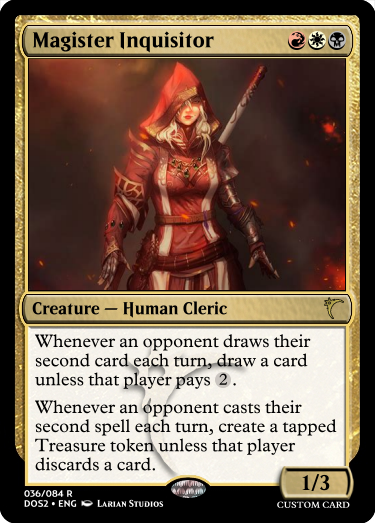
Magister Inquisitor RWB
Creature—Human Cleric
Whenever an opponent draws their second card each turn, draw a card unless that player pays 2.
Whenever an opponent casts their second spell each turn, create a tapped Treasure token unless that player discards a card.
[1/3]
All told, I expect the card value of this deck to be upwards of $80 once the prices settle, and so that's an easy pass—not the most valuable precon ever printed, but more than worth the price tag with plenty of potential to make your money back and more if you decide the deck isn't to your taste.
That said, financial value is only one factor when it comes to purchasing a precon—the more important question for many is, how does it play? Is it fun? Does it hold together well out of the box? What can I expect if I roll up with this deck to my LGS? Let's talk about that.
Play value
Hitting the fundamentals
We all love to focus on the big flashy spells and fun strategies of our decks, but in order for those flashy spells to be cast and for those strategies to unfold we first need to make sure our foundations are strong. This is why I begin every play review of a precon with a look at the fundamentals—the mana base, draw engines, ramp and removal that will allow us to advance our game plan and keep our opponents' in check until we can start to snowball out of hand.
Starting with the mana base, the deck runs 38 lands including the back side of Kabira Takedown // Kabira Plateau
, including 13 basics,
4 lands that can produce any colour of the deck, 2 fetches, 5 utility lands (3 of which produce coloured mana, 2 white and 1 black), and the rest situationally
tapped dual lands. These lands are supported by 7 mana rocks and 9 other cards which can provide ramp in the form of treasures or lands. Many of these
latter ramp cards provide some other benefit for the deck—for example, Magister Assassin can provide a burst of ramp in a pinch or act as a
removal spell, while The Order's Share taxes your opponents if they want to build any kind of board presence and
Keeper of the Accord
helps build
your board if someone gets ahead of you.
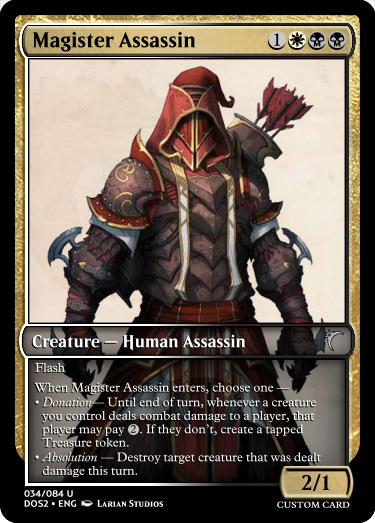
Magister Assassin 1WBB
Creature—Human Assassin
Flash
When Magister Assassin enters, choose one:
- Donation—Until end of turn, whenever a creature you control deals combat damage to a player, that player may pay 2. If they don't, create a tapped Treasure token.
- Absolution—Destroy target creature that was dealt damage this turn.
[2/1]
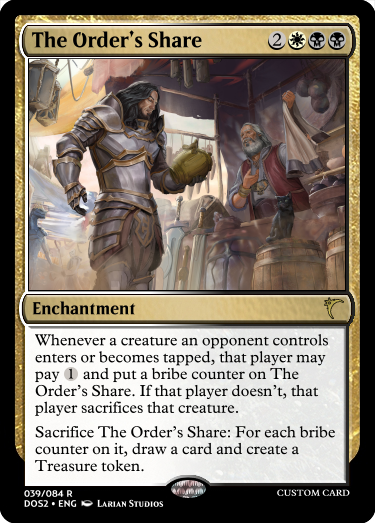
The Order's Share 2WBB
Enchantment
Whenever a creature an opponent controls enters or becomes tapped, that player may pay 1 and put a bribe counter on The Order's Share. If that player doesn't, that player sacrifices that creature.
Sacrifice The Order's Share: For each bribe counter on it, draw a card and create a Treasure token.
This broad mana base does a pretty good job of supporting the coloured requirements of the deck. The deck includes 50 white pips (46%), 34 red (31%), and 24 black (22%), while the mana base includes 29 (43%) sources of white mana, 22 (32%) sources of red, and 17 (25%) black sources, with the shift from white to black providing some extra support in ensuring the commander can still hit the board on time. These numbers also don't account for the many sources of treasure production, which are able to provide further mana fixing. Of course, of the 38 lands in the deck, 8 always enter tapped, and a further 7 might enter tapped dependent on the game state—this is a precon after all— but nevertheles I feel this base provides a strong foundation on which the player can build their own improvements, without putting an out-of-the-box player too much on the back foot.
With mana and ramp out of the way, the next key pillar to consider is draw. 16 of the cards in this deck can be broadly classified as draw spells,
although that includes cards like Boros Strike-Captain
and
Outpost Siege
that provide impulse
draw rather than lasting card advantage. One notable property of most of the draw engines in the deck is that they rely on swinging in. This is something
of a double-edged sword—on the one hand, you want to be swinging early and often anyway, so rewarding you for doing just that gives the deck a smoothly
synergistic feel; on the other hand, if your opponents manage to get ahead and create a board that you simply cannot swing into, you're going to struggle to
find the out; Dark Tutelage
and
Discerning Financier
will help you get there,
but the former is going to risk your life total and the latter requires going negative in mana yourself while handing free mana to your opponents, not something you
want to be doing if you're already behind. That said, the sheer quantity of draw in this deck will go a long way to make sure that you can get answers into your hand
early, and as long as you are circumspect about when to hold removal this will carry you a long way.
I've already talked about several of the new cards with draw effects in this article already—The Red Prince, Heir to Empire and Magister Inquisitor are particularly potent examples—but I would be remiss not to give a special mention here to Magisters' Bond, a funky little enchantment which can provide flexible ramp, draw, or pump depending on your turn-by-turn needs. This little trick stands out particularly for triggering not just on offence but on defence as well—if someone is swinging at you turn after turn, committing just two tokens to blocking each turn will help you ramp and draw into the answers you need, while the on-board combat trick may allow you to catch out an unwary foe.
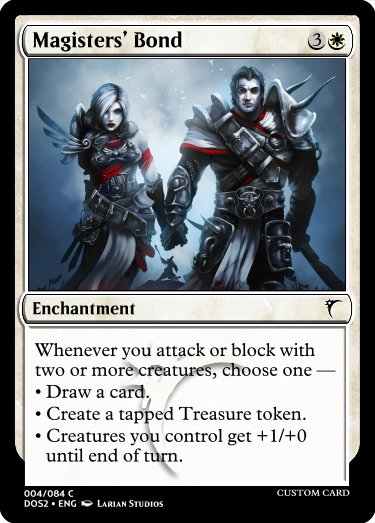
Magisters' Bond 3W
Enchantment
Whenever you attack or block with two or more creatures, choose one—
- Draw a card.
- Create a tapped Treasure token.
- Creatures you control get +1/+0 until end of turn.
Lastly, let's talk removal. The deck runs 19 cards that could be broadly described as 'removal', with varying levels of potency and flexibility, with some
standout inclusions and notable omissions. I've already mentioned Anguished Unmaking
when talking value for
money, and this remains a moderately efficient response to a majority of threats. Crackling Doom
provides effecient and
wide removal that dodges most common forms of protection, while a suite of efficient sweepers with upside including Promise of Loyalty
,
Ruinous Ultimatum
and the all new
Lucian's Ascension provide a robust answer to boards that go wide rather than tall.
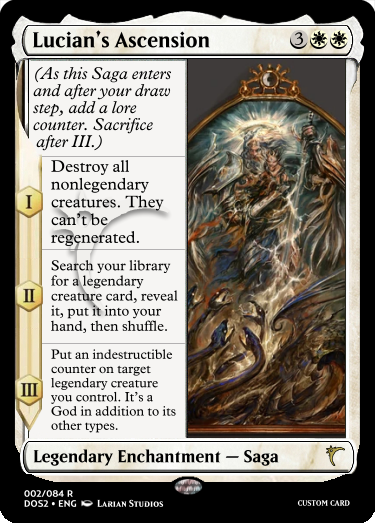
Lucian's Ascension 3WW
Legendary Enchantment—Saga
(As this Saga enters and after your draw step, add a lore counter. Sacrifice after III.)
- Destroy all nonlegendary creatures. They can't be regenerated.
- Search your library for a legendary creature card, reveal it, put it into your hand, then shuffle.
- Put an indestructible counter on target legendary creature you control. It's a God in addition to its other types.
These one-off removal cards are further supplemented by a number of scary repeatable removal engines which will provide continuous pressure against
your opponents until they are answered. Standouts in this category include Kroxa, Titan of Death's Hunger
for
continually ripping your opponents' hands and Archon of Cruelty
to whittle away
their board presence besides. The deck even runs a single counterspell, Mana Tithe
, though
the absence of a Reprieve
makes this feel like more of
a flavourful inclusion than any indication that the deck is hoping to use counter magic to protect its plays.
With the good on this front out the way, let's talk a little about the bad, or at least the less good. Most recent white precons have included one of the
two premier hyperefficient white removal spells, but both Swords to Plowshares
and
Path to Exile
are missing here.
Additionally, while the removal suite has a lot of flexibility, it has no means of removing lands—no 'any permanent' removal like
Generous Gift
or
Chaos Warp
and no targetted
land removal like Wasteland
—
making the deck quite helpless in the face of powerful land threats like Cabal Coffers
or
Gaea's Cradle
. There's also a
notable lack of graveyard hate, with fairly limited exile-based removal to boot, which together make the deck vulnerable to reanimator and
other similar graveyard-based strategies.
Levying taxes
So that's our vegetables out the way, now let's get to the good stuff. The tagline for this precon is 'Rally the Troops / Tax the Enemy', which suggests two key themes—wide creature-based aggro and some kind of taxing or stax. I'm going to talk about the second theme first, because despite making it onto the tagline it represents a very minor theme in the final deck—only 5 cards that even vaguely fit this category, bumping up to around 7 if you include one-off taxing effects like Mana Tithe and the new Magister Assassin (see above). That's not really enough presence to really call it a theme of the deck, so it is perhaps more appropriate to say that some number of the ramp and draw spells in the deck have a taxing or staxing dimension to them.
We've already talked about Magister Inquisitor and The Order's Share as two standout entries in this category, and a further special
mention ought to go the Silent Monk, which functions as a kind of heavily toned-down and less explosive Hullbreacher
in Orzhov. In the early
game this is likely to amount to little more than an annoying drain effect that will force everyone to play their draw as if they were in black, but if you
can get it to stick into the late game when life totals start to tumble this can quickly force opponents to choose between giving up their draws, sacking their
boards, or ramping you into the late game.

Silent Monk WBB
Creature—Human Horror Monk
Flash
Menace
If an opponent would draw a card except the first one they draw in each of their draw steps, that player may pay 3 life or sacrifice a nontoken permanent. If the player doesn't, instead that player skips that draw and you create a tapped Treasure token.
[2/2]
Going on the offensive
The real meat of the deck is found in its second theme, a go-wide creature strategy that aims to swing wide and swing often. The set-up comes in the form of a
handful of token generators and cheap aggressive creatures that can be deployed in the first few turns of the game while greedier midrange decks are still
ramping up. The former group includes standout picks such as Warren Warleader
and the aforementioned
Adeline, Resplendent Cathar, as well as new cards such as Alexander the Innocent and Magister Knight.
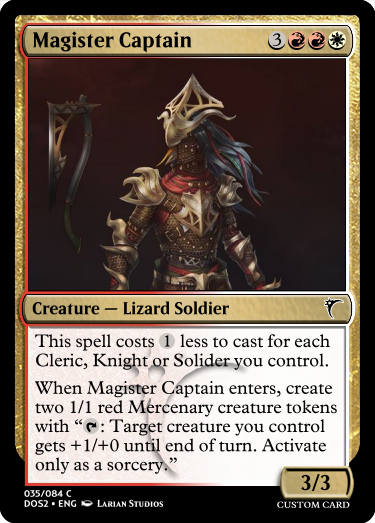
Magister Captain 3RRW
Creature—Lizard Soldier
This spell costs 1 less to cast for each Cleric, Knight or Solider you control.
When Magister Captain enters, create two 1/1 red Mercenary creature tokens with “T: Target creature you control gets +1/+0 until end of turn. Activate only as a sorcery.”
[3/3]
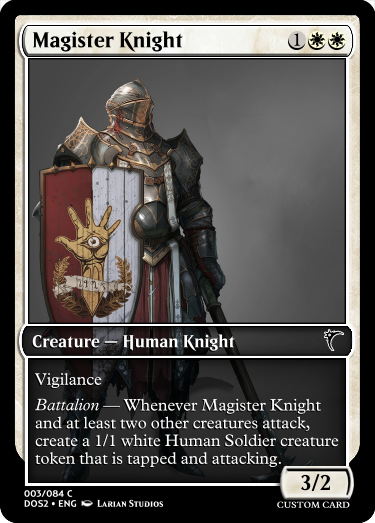
Magister Knight 1WW
Creature—Human Knight
Vigilance
Battalion—Whenever Magister Knight and at least two other creatures attack, create a 1/1 white Human Soldier creature token that is tapped and attacking.
[3/2]
Evasion, pumping effects, and protection from the likes of Legion Loyalist
,
Tory D'Avenant, Fury Rider
and
the new Boros overrun effect in Raise the Banner protect all your little guys and help make sure they survive to swing in for another combat
down the line. Many of these effects last until end of turn, and so can be profitably paired with any of the extra combat steps provided by cards
like Aurelia, The War Leader
and the Resurgence
side of
Response // Resurgence
to accumulate
insurmountable advantage or remove a player from the game through an overwhelming barrage of attacks.
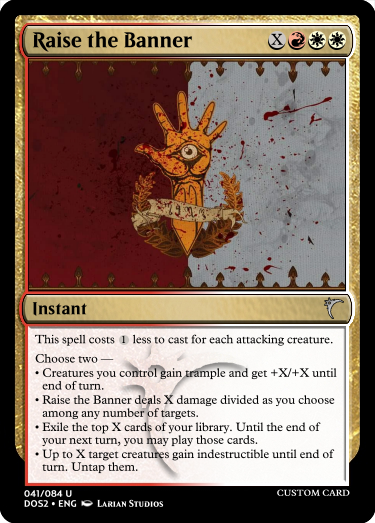
Raise the Banner XRWW
Instant
This spell costs 1 less to cast for each attacking creature.
Choose two—
- Creatures you control gain trample and get +X/+X until end of turn.
- Raise the Banner deals X damage divided as you choose among any number of targets.
- Exile the top X cards of your library. Until the end of your next turn, you may play those cards.
- Up to X target creatures gain indestructible until end of turn. Untap them.
The pay off for all this aggression is a range of benefits, from card draw from Chivalric Alliance to even more damage that can be used to remove
problematic blockers or, in the case of Firemane Avenger
, hit the opponent even
harder to push for that last damage necessary for lethal. And let's not forget that if Dallis is on the field, each of these attackers is buffing
every other attacker and converting into tokens through Dallis's Battalion ability.
One notable gap is a lack of much in the way of board-wide protection or recursion, which might make it difficult for this deck to bounce back from a
sweeper. The one exception to this general lack is Alexander the Innocent, which offers Sun Titan
-like recursion for your cheaper
creatures, alongside extra potential if you swing in with a wide enough board.

Alexander the Innocent 1RWW
Legendary Creature—Human Cleric
Battle cry, lifelink (Whenever this creature attacks, each other attacking creature gets +1/+0 until end of turn.)
Battalion—Whenever Alexander and at least two other creatures attack, you may return target creature with mana value 3 or less from your graveyard to the battlefield tapped and attacking. Then if you control ten or more attacking creatures, creatures you control gain indestructible until end of turn.
[2/5]
All told, this is a deck that loves to turn creatures sideways and rewards you with a variety of advantage for doing so. It has its weaknesses, but in a pool of precons otherwise heavily composed of control and midrange value piles this deck's ability to get in early, fast and hard provides an opportunity to punish greedy opponents and send life totals tumbling. With a range of overrun and extra combat options, the deck is more than able to close out the late game, providing a flexible aggro experience that rewards you for getting into the weeds of the red zone as often as possible.
But don't take my word for it—the full deck list is provided below!
Decklist
New cards with this product are marked with a star (★).
Commander (1)

Creatures (31)








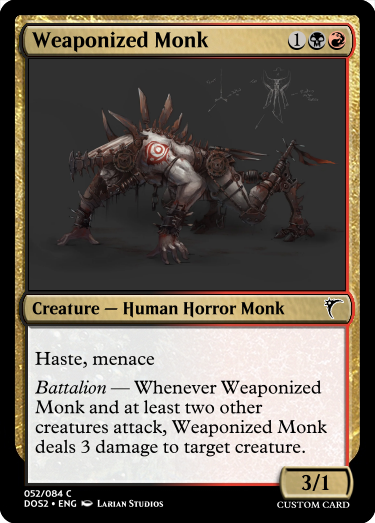
Artifacts (9)
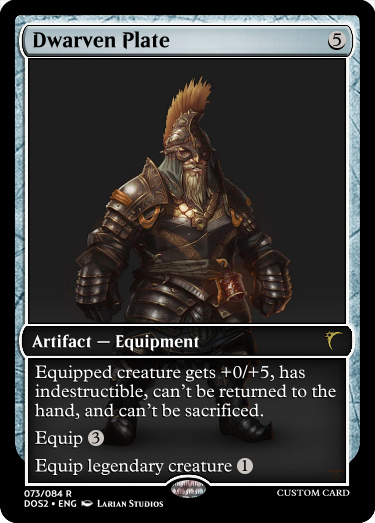
Enchantments (13)
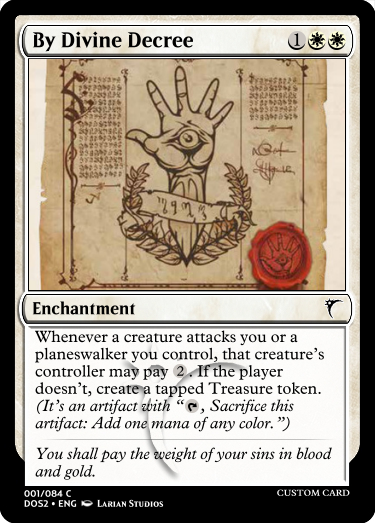



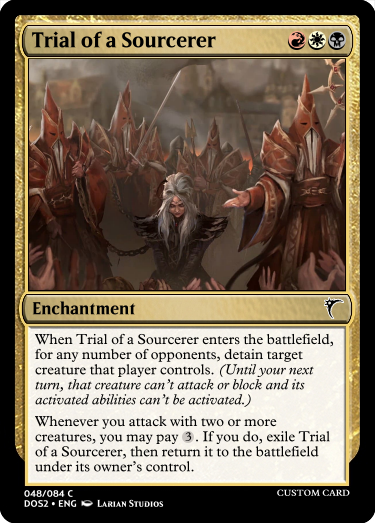
Instants (7)

Sorceries (3)
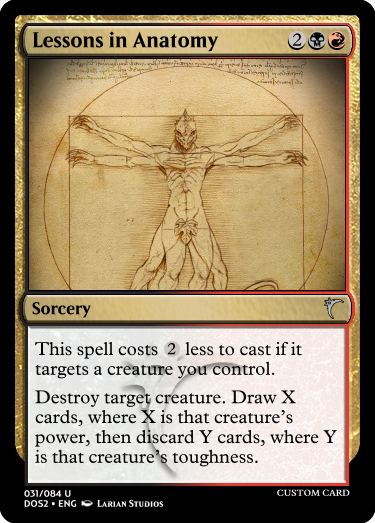
Lands (37)
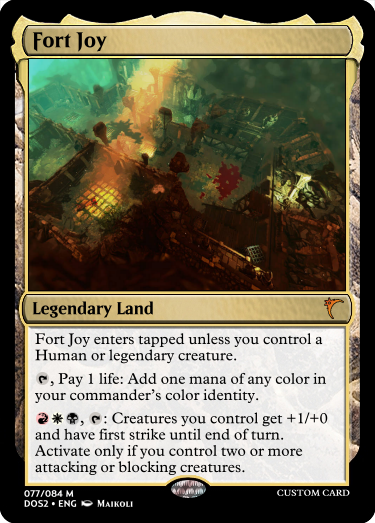
Final grade
All told, the Divine Majesty precon earns a solid B+ grade.
The monetary value is excellent, with a couple of very nice high value chase cards alongside a body of other valuable reprints that guarantee you'll get your money's worth for your purchase. The play concept of the deck is excellent, and supported by a number of potent cards, but these cards don't all hold together quite as well as one might like, and there are just enough gaps and weak points to prevent the play feel reaching those coveted higher grades. This issue is certainly compouned by the fact that one of the key tagline themes of the deck, the taxing/staxing theme, is barely present, which might lead some buyers to feel misled by the advertising for the product. Clearly combining aggro and tax/stax is a challenging prospect, and this deck certainly gives it a good shot with a handful of standout cards like Silent Monk providing bridges between the two strategies, but overall I feel like it just doesn't quite manage to hit the landing.
That said, the monetary value of the deck is good enough to justify picking it up despite its weaknesses, and for all that it is still great fun to play—I would strongly recommend jamming a few games before taking the deck apart for the reprints, just to see how it feels. Having a deck that forces you to swing every round helps overcome the natural reticence that many of us Commander players have towards turning our creatures sideways and does so in a way that feels rewarding while still accelerating the game towards a meaningful conclusion. Dallis herself is a beast of a commander, and while I'm not convinced this precon represents the best possible shell for her, I will definitely be dabbling with building a new home for her over the next few months!
| ← Back (Announcement) | ↑ Top |